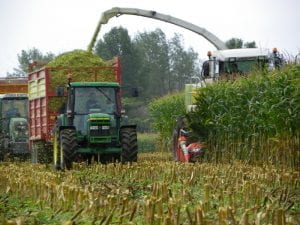by Ali Nafchi

Before the beginning of each harvesting season, the forage harvester should be entirely inspected. This inspection is to make sure that the machine is in excellent working condition, to avoid costly machine breakdowns and also, prevent delay in harvesting time. All parts especially parts in contact with stalk of corn from the front tip of the harvester head all the way to the spout should be subjected to inspection. Clean the forage harvester in and out, if this was not done at the last storage. Reinstall all the V-belts that you have removed after season, check the belts’ tension, and secure the safety covers. Re-lubricate the complete forage harvester as described in the lubricating charts. After lubrication is done double-check the moving parts and while you are aware of safety requirements, run the forage harvester at low-speed for a few minutes and re-check all moving parts, belts, pulleys bearings and look for any malfunctioning. Inspect each part and make sure that part is ready and good for another season.
Check for any cracked, loose, worn, or/and missing bolts in the corn head and the pivot bolts. All the knives on the corn head and teeth on the gathering drums or auger should be inspected. Remember that head performance will have an effect on harvester performance, therefore, any missing or broken parts on the head will have impact on entire harvesting operation. Next is to check the crop flow, visually checking all liners, ledges, rollers, bearings, springs, grease lines, electric harnesses, and hydraulic lines. If you have any doubt about replacing a part that can be stocked on your farm, you may decide to be prepared and order parts now so you have them on-hand when they need to be replaced. Inspect the gearboxes, check for fluid level. If the oil is low, there must be a problem, check for any possible leaks before an oil change. (If you do not find the problem now or before harvest, you will find it during harvest!). Be aware that seals are not expensive, but running the gears without oil can cause serious costly damage to the gearbox.
Inspect the Engine and Safety
Check the oil, brake fluid, coolant level while checking all seals and change them if needed. Always, ask the dealer for advice or use the operator’s manual (it is in the box below the seat) and read if needed. The first 45 pages of the operator’s manual book is related to the safe operation of the chopper which is the most important part. Check the fire extinguishers and make sure they are fully charged. Check all safety alarms including; the caution lights, back up beeper, back up lights, and the cutter head beeper. You may want to train your entire harvesting team before harvesting season, especially if you have a new employee (let them know how things work and safety always is first).
For more information please visit:

